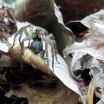(Press-News.org) PITTSBURGH—Learning a new skill is easier when it is related to ability that we already possess. For example, a trained pianist might learn a new melody more easily than learning how to hit a tennis serve.
Neural engineers from the Center for the Neural Basis of Cognition (CNBC)—a joint program between the University of Pittsburgh and Carnegie Mellon University—have discovered a fundamental constraint in the brain that may explain why this happens. Published as the cover story in the Aug. 28, 2014, issue of Nature, they found for the first time that there are constraints on how adaptable the brain is during learning and that these constraints are the key determinant for whether a new skill will be easy or difficult to learn. Understanding the ways in which the brain's activity can be "flexed" during learning could eventually be used to develop better treatments for stroke and other brain injuries.
Lead author Patrick T. Sadtler, a PhD candidate in Pitt's Department of Bioengineering, compared the study's findings to cooking.
"Suppose you have flour, sugar, baking soda, eggs, salt, and milk. You can combine them to make different items—bread, pancakes, and cookies—but it would be difficult to make hamburger patties with the existing ingredients," Sadtler said. "We found that the brain works in a similar way during learning. We found that subjects were able to more readily recombine familiar activity patterns in new ways relative to creating entirely novel patterns."
For the study, the research team trained animals to use a brain-computer interface (BCI), similar to ones that have shown recent promise in clinical trials for assisting tetraplegics and amputees.
"This evolving technology is a powerful tool for brain research," said Daofen Chen, program director at the National Institute of Neurological Disorders and Stroke (NINDS), part of the National Institutes of Health (NIH), which supported this research. "It helps scientists study the dynamics of brain circuits that may explain the neural basis of learning."
The researchers recorded neural activity in the motor cortex and directed the recordings into a computer, which translated the activity into movement of a cursor on the computer screen. This technique allowed the team to specify the activity patterns that would move the cursor. The subjects' goal was to move the cursor to targets on the screen, which required them to generate the patterns of neural activity that the experimenters had requested. If the subjects could move the cursor well, that meant that they had learned to generate the neural activity pattern that the researchers had specified.
The researchers found that their subjects learned to generate some neural activity patterns more easily than others, since they only sometimes achieved accurate cursor movements. The harder-to-learn patterns were different from any of the pre-existing patterns, whereas the easier-to-learn patterns were combinations of pre-existing brain patterns. Because the existing brain patterns likely reflect how the neurons are interconnected, the results suggest that the connectivity among neurons shapes learning.
"We wanted to study how the brain changes its activity when you learn and also how its activity cannot change. Cognitive flexibility has a limit—and we wanted to find out what that limit looks like in terms of neurons," said Aaron P. Batista, assistant professor of bioengineering at Pitt and co-principal investigator on the study with Byron M. Yu, assistant professor of electrical and computer engineering and biomedical engineering at Carnegie Mellon. Yu believes this work demonstrates the utility of BCI for basic scientific studies that will eventually impact people's lives.
"These findings could be the basis for novel rehabilitation procedures for the many neural disorders that are characterized by improper neural activity," Yu said. "Restoring function might require a person to generate a new pattern of neural activity. We could use techniques similar to what were used in this study to coach patients to generate proper neural activity."
INFORMATION:
For more information on how the brain's existing neural patterns show how learning can be difficult, watch the researchers discuss the study in this short video: http://youtu.be/9ihQkxtt6pM.
The CNBC is devoted to investigating the neural mechanisms that give rise to human cognitive abilities. The center integrates the strengths of the University of Pittsburgh in basic and clinical neuroscience with Carnegie Mellon's strengths in psychology, computer science, biological sciences, and statistics and sponsors an interdisciplinary graduate training program. The CNBC will celebrate its 20th anniversary of advancing brain, computation, and behavior through research and education this fall. Visit http://www.cnbc.cmu.edu/ for more information.
The research was funded by the National Institutes of Health, the National Science Foundation, and the Burroughs Wellcome Fund.
In addition to Sadtler, Batista, and Yu, the research team included Pitt's Kristin Quick and Elizabeth Tyler-Kabara, CMU's Matthew Golub and Steven Chase, and Stephen Ryu of Stanford University and the Palo Alto Medical Foundation.
Pitt and Carnegie Mellon engineers discover why learning can be difficult
Findings, published in Nature, could lead to improved treatments for stroke, other brain injuries
2014-08-27
ELSE PRESS RELEASES FROM THIS DATE:
Kessler Foundation scientists study impact of cultural diversity in brain injury research
2014-08-27
West Orange, NJ. August 27, 2014. Kessler Foundation scientists examined the implications for cultural diversity and cultural competence in brain injury research and rehabilitation. The article by Anthony Lequerica, PhD, and Denise Krch, PhD: Issues of cultural diversity in acquired brain injury (ABI) rehabilitation (doi:10.3233/NRE-141079) was published by Neurorehabilitation. Drs. Lequerica and Krch are research scientists in Traumatic Brain Injury (TBI) Research at Kessler Foundation and co-investigators for the Northern New Jersey TBI Model System.
Cultural sensitivity ...
New smartphone app can detect newborn jaundice in minutes
2014-08-27
Newborn jaundice: It's one of the last things a parent wants to deal with, but it's unfortunately a common condition in babies less than a week old.
Skin that turns yellow can be a sure sign that a newborn is jaundiced and isn't adequately eliminating the chemical bilirubin. But that discoloration is sometimes hard to see, and severe jaundice left untreated can harm a baby.
University of Washington engineers and physicians have developed a smartphone application that checks for jaundice in newborns and can deliver results to parents and pediatricians within minutes. ...
Parents, listen next time your baby babbles
2014-08-27
Pay attention, mom and dad, especially when your infant looks at you and babbles.
Parents may not understand a baby's prattling, but by listening and responding, they let their infants know they can communicate which leads to children forming complex sounds and using language more quickly.
That's according to a new study by the University of Iowa and Indiana University that found how parents respond to their children's babbling can actually shape the way infants communicate and use vocalizations.
The findings challenge the belief that human communication is innate ...
Lifetime of fitness: A fountain of youth for bone and joint health?
2014-08-27
ROSEMONT, Ill.—Being physically active may significantly improve musculoskeletal and overall health, and minimize or delay the effects of aging, according to a review of the latest research on senior athletes (ages 65 and up) appearing in the September issue of the Journal of the American Academy of Orthopaedic Surgeons (JAAOS).
It long has been assumed that aging causes an inevitable deterioration of the body and its ability to function, as well as increased rates of related injuries such as sprains, strains and fractures; diseases, such as obesity and diabetes; and ...
Educated consumers more likely to use potentially unreliable online healthcare information
2014-08-27
The last time you experienced worrisome medical symptoms, did you look for advice online before consulting a health-care professional? If so, you're not alone. Consumers are increasingly turning to forums, video-sharing sites, and peer support groups to gather anecdotal information and advice, which may distract them from more reliable and trustworthy sources. New research to be presented at the HFES 2014 Annual Meeting in Chicago studies the characteristics of consumers who use the Internet to collect health-care information.
"Age, educational levels, and health status ...
Southwest may face 'megadrought' this century
2014-08-27
Due to global warming, scientists say, the chances of the southwestern United States experiencing a decade long drought is at least 50 percent, and the chances of a "megadrought" – one that lasts over 30 years – ranges from 20 to 50 percent over the next century.
The study by Cornell University, University of Arizona and U.S. Geological Survey researchers will be published in a forthcoming issue of the American Meteorological Society's Journal of Climate.
"For the southwestern U.S., I'm not optimistic about avoiding real megadroughts," said Toby Ault, Cornell assistant ...
Scientist uncovers red planet's climate history in unique meteorite
2014-08-27
TALLAHASSEE, Fla. — Was Mars — now a cold, dry place — once a warm, wet planet that sustained life? And if so, how long has it been cold and dry?
Research underway at the National High Magnetic Field Laboratory may one day answer those questions — and perhaps even help pave the way for future colonization of the Red Planet. By analyzing the chemical clues locked inside an ancient Martian meteorite known as Black Beauty, Florida State University Professor Munir Humayun and an international research team are revealing the story of Mars' ancient, and sometimes startling, ...
MU researchers develop more accurate Twitter analysis tools
2014-08-27
COLUMBIA, Mo. – "Trending" topics on the social media platform Twitter show the quantity of tweets associated with a specific event. However, trends only show the highest volume keywords and hashtags, and may not give qualitative information about the tweets themselves. Now, using data associated with the Super Bowl and World Series, researchers at the University of Missouri have developed and validated a software program that analyzes event-based tweets and measures the context of tweets rather than just the quantity. The program will help Twitter analysts gain better ...
Marijuana compound may offer treatment for Alzheimer's disease
2014-08-27
Tampa, FL (Aug. 26, 2014) -- Extremely low levels of the compound in marijuana known as delta-9-tetrahydrocannabinol, or THC, may slow or halt the progression of Alzheimer's disease, a recent study from neuroscientists at the University of South Florida shows.
Findings from the experiments, using a cellular model of Alzheimer's disease, were reported online in the Journal of Alzheimer's Disease.
Researchers from the USF Health Byrd Alzheimer's Institute showed that extremely low doses of THC reduce the production of amyloid beta, found in a soluble form in most aging ...
More wolf spiders feasting on American toads due to invasive grass, UGA study shows
2014-08-27
Athens, Ga. – An invasive grass species frequently found in forests has created a thriving habitat for wolf spiders, who then feed on American toads, a new University of Georgia study has found.
Japanese stiltgrass, which was accidentally introduced to the U.S. in the early 1900s, is one of the most pervasive invasive species and has spread to more than a dozen states in the past century, particularly in the Southeast. Typically found along roads and in forests, it can survive in widely diverse ecosystems and has been found to impact native plant species, invertebrate ...
LAST 30 PRESS RELEASES:
Decoupling the HOR enhancement on PtRu: Dynamically matching interfacial water to reaction coordinates
Sulfur isn’t poisonous when it synergistically acts with phosphine in olefins hydroformylation
URI researchers uncover molecular mechanisms behind speciation in corals
Chitin based carbon aerogel offers a cleaner way to store thermal energy
Tracing hidden sources of nitrate pollution in rapidly changing rural urban landscapes
Viruses on plastic pollution may quietly accelerate the spread of antibiotic resistance
Three UH Rainbow Babies & Children’s faculty elected to prestigious American Pediatric Society
Tunnel resilience models unveiled to aid post-earthquake recovery
Satellite communication systems: the future of 5G/6G connectivity
Space computing power networks: a new frontier for satellite technologies
Experiments advance potential of protein that makes hydrogen sulfide as a therapeutic target for Alzheimer’s disease
Examining private equity’s role in fertility care
Current Molecular Pharmacology achieves a landmark: real-time CiteScore advances to 7.2
Skeletal muscle epigenetic clocks developed using postmortem tissue from an Asian population
Estimating unemployment rates with social media data
Climate policies can backfire by eroding “green” values, study finds
Too much screen time too soon? A*STAR study links infant screen exposure to brain changes and teen anxiety
Global psychiatry mourns Professor Dan Stein, visionary who transformed mental health science across Africa and beyond
KIST develops eco-friendly palladium recovery technology to safeguard resource security
Statins significantly reduce mortality risk for adults with diabetes, regardless of cardiovascular risk
Brain immune cells may drive more damage in females than males with Alzheimer’s
Evidence-based recommendations empower clinicians to manage epilepsy in pregnancy
Fungus turns bark beetles’ defenses against them
There are new antivirals being tested for herpesviruses. Scientists now know how they work
CDI scientist, colleagues author review of global burden of fungus Candida auris
How does stroke influence speech comprehension?
B cells transiently unlock their plasticity, risking lymphoma development
Advanced AI dodel predicts spoken language outcomes in deaf children after cochlear implants
Multimodal imaging-based cerebral blood flow prediction model development in simulated microgravity
Accelerated streaming subgraph matching framework is faster, more robust, and scalable
[Press-News.org] Pitt and Carnegie Mellon engineers discover why learning can be difficultFindings, published in Nature, could lead to improved treatments for stroke, other brain injuries





